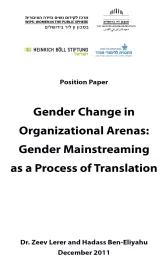Gender Change in Organizational Arenas: Gender Mainstreaming as a Process of Translation
Over the last three decades, ever since Rosabeth Moss Canter (1977) focused our attention on
the status of women in work organizations, feminist organizational research and theorizing
developed sharp analytical tools for recognizing and deciphering the gendered nature inherent in
work organizations (Acker 2006; Acker 1990; Meyerson and Kolb 2000; Yancey-Martin 2006). Their
gendered structures, practices and internal cultures, as well as their gendering effect on society,
had been studied and understood. This analytical drive was accompanied by much reflection
and development of change ideas and practices: from equal opportunity, affirmative action and
sexual harassment legislation, to training and empowerment plans and, more recently, strategies
of gender mainstreaming (Kalev, Dobin and Kelly 2006).
The question of women's position, power and status in organizations is essential to promoting
gender equality, since organizations and social institutions provide the central arenas and settings
in which gender hierarchies, inequalities and disadvantages are created and reproduced. In today's
organizations and institutions, formal and overt discrimination is less evident and detectable as a
result of legislation that prohibits and restricts them. Instead, gender hierarchies and disadvantages
continue to be created and reproduced by a complex array of informal and subtle practices,
mechanisms and discourses which are deeply embedded in organizational structures and cultures.
Initializing and mobilizing gender change within organizations becomes, therefore, much more
complex.
Over the years, it became obvious that there is no easy fusion between the sophisticated deciphering
tools and the vast range of change plans and prescriptions. In other words, it is the experience of
most practitioners that while we can often identify the problems and outline the plan to correct
them, we still cannot manage to implement the desired (and many times obvious) course of action
on the way to equality. This frustrating gap cannot be dismissed as just another proof of the deeprootedness
of patriarchy, prevalence of chauvinism or the marginal position of women. All these are
of course part of it, but prevent an in-depth optimistic inquiry into this gap.
